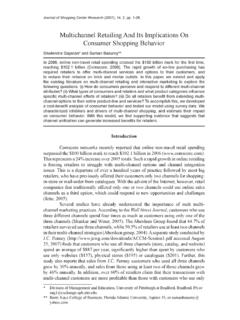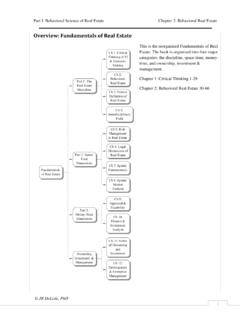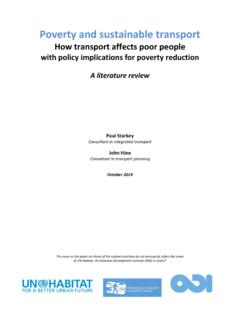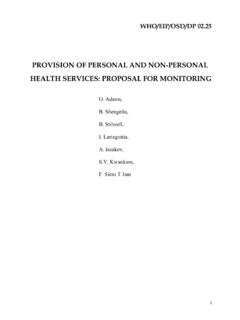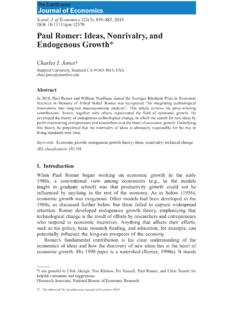Transcription of Overview: Fundamentals of Real Estate
1 Part I: Behavioral Science of Real Estate Chapter 2: Behavioral Real Estate JR DeLisle, PhD i i Overview: Fundamentals of Real Estate This is the reorganized Fundamentals of Real Estate . The book is organized into four major categories: the discipline, space-time, money-time, and ownership, investment & management. Chapter 1: Critical Thinking 1-29 Chapter 2: Behavioral Real Estate 30-66 Behavioral Real Estate Theory ii Table of Contents Contents Behavioral Nature of Real Estate ..32 The Real Estate Discipline.
2 32 Key Participants in Real Estate ..33 Key Participants in Real Estate ..33 Behavioral Real Estate ..34 Confidence Levels and Most Probable Price ..34 Behavioral Concepts in Real Estate ..35 Market Segmentation ..35 Market Segmentation and Market Targeting ..35 Requirements for Market Segmentation ..36 Bases for Market Segmentation ..37 Space User Perspective ..38 Employment Segmentation ..39 Pension Fund: Behavioral Segmentation ..40 Rationale Behavior ..41 The Notion of Involvement ..41 Low vs. High Involvement Decisions.
3 41 Theories of Behavior ..45 Behavioral Models of Man ..45 Needs and Wants ..46 Maslow s Needs ..46 Behavioralism in the Price-Setting Process ..47 Behavioral Price-Setting Process ..47 Importance of Behavioralism ..47 Importance of Price-Setting Process ..48 Dyadic Relationships and Negotiations ..49 Value Concepts in Dyadic Relationships ..49 Positioning Value Concepts ..49 Subjective Value to Seller ..50 Subjective Value to Buyer ..50 Part I: Behavioral Science of Real Estate Chapter 2: Behavioral Real Estate JR DeLisle, PhD iii iii Exhibit 2- 20.
4 50 Bidding and Zone of Negotiation ..50 A Cyclical Look at Market Value vs. Investment Value ..51 Market Value vs. Investment Value ..51 The Nature of Value ..51 Bid-Ask Spread ..52 Confidence Levels and Transaction Values ..52 Investment Value and Owner Confidence ..52 Confident Owner/Buyer IVs ..53 Confident Owner/Buyer IVs ..53 Confident Owner/Uncertain Buyer ..54 Confident Owner/New Buyer ..54 Real Estate Cycles and Confidence Levels ..55 Cycles in Real NCREIF Market Cycles: 1978-2010 ..55 Market Expectations and Real Estate Cycles.
5 55 The Role of Theory in Real Estate ..56 Bid-Rent Theory ..57 Change in Transportation Costs ..57 Urban CBD-Oriented Market ..58 Multi-Nucleated Market ..58 Residual Land Theory & Economic Mobility ..59 Vulnerable, Vulnerable, Vulnerable vs. L, L, L ..59 Residual Land Value Calculation ..60 Urban Land Economics Theory ..61 Linkages Among Urban Land Economics Theories ..61 Structure Theory, Succession Theory, and Situs Theory ..61 Structure Theory ..62 Seattle s Market Structure and Landform ..63 Succession Theory.
6 63 Succession Theory ..63 Situs Theory ..64 Situs Theory Overview ..64 Situs Theory at a Global Level ..65 Behavioral Real Estate Theory iv Integration of ULE Theories ..65 Summary Chapter 2 ..66 Section 3: Chapter Next ..67 Behavioral Real Estate Theory 30 Blank for layout only This page deliberately blank Chapter2: Real Estate as a Behavioral Science JR DeLisle, PhD 31 31 Succession Theory Preview Chapter 1 Overview This chapter introduces students to the real Estate as a behavioral science.
7 This classification comes from the unique nature of the market in which all transactions are negotiated. This unique market mechanism distinguishes real Estate from other asset classes. At the same time, it argues for more efforts to understand how space consumers make real Estate decisions. To add more precision, the notion of market segmentation is introduced as a way of identifying the usual suspects and focusing on the most probable buyers. The chapter provides an overview of consumer behavior theory and then extends that theory to the real Estate market.
8 It introduces the notions of perception and perceptual biases. It explores high- involvement decisions and explains how spatial consumers approach high involvement decisions. The discussion also explores wants and needs using Maslow s pyramid of needs as a point of discussion. To provide an example of behavioral theory, the impact of confidence levels on the price setting process is explored. The discussion also introduces land residual theory and urban land economics theory. What you will learn in Chapter 2. How real Estate differs from other asset classes.
9 How real Estate is a behavioral science. How market segmentation can be extended to real Estate . How consumers approach high-involvement decisions. Behavioral models of man. The difference between needs and wants. The price-setting process. The importance of subjective values and changes over time. Bid-rent theory and gravity models. Land Residual Value Theory. Urban Land Economics Theory Example. See example of traditional Land Residual Theory Step 1. Income Estimation. Step 2. Rate of Return Extraction.
10 Step 3. Value Conversion: Income/Rate. Step 4. Allocation to Factors of Production. Step 5. Residual Land Valuation Key Contructs: Urban Land Economics Theory Behavioral Real Estate Theory 32 Behavioral Nature of Real Estate The Real Estate Discipline Real Estate is a real or tangible asset in the sense that it has physical components. Real Estate is also bestowed with a bundle of rights ( , right to enjoy, occupy, use and transfer), the scope of which is determined by legal/political processes that have jurisdiction over it.


